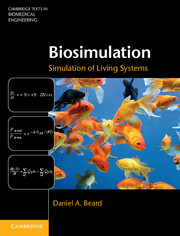Book contents
- Frontmatter
- Contents
- Preface
- Extracts
- 1 Introduction to simulation of biological systems
- 2 Transport and reaction of solutes in biological systems
- 3 Physiologically based pharmacokinetic modeling
- 4 Cardiovascular systems simulation
- 5 Chemical reaction systems: thermodynamics and chemical equilibrium
- 6 Chemical reaction systems: kinetics
- 7 Chemical reaction systems: large-scale systems simulation
- 8 Cellular electrophysiology
- 9 Appendices: mathematical and computational techniques
- References
- Index
7 - Chemical reaction systems: large-scale systems simulation
Published online by Cambridge University Press: 05 June 2012
- Frontmatter
- Contents
- Preface
- Extracts
- 1 Introduction to simulation of biological systems
- 2 Transport and reaction of solutes in biological systems
- 3 Physiologically based pharmacokinetic modeling
- 4 Cardiovascular systems simulation
- 5 Chemical reaction systems: thermodynamics and chemical equilibrium
- 6 Chemical reaction systems: kinetics
- 7 Chemical reaction systems: large-scale systems simulation
- 8 Cellular electrophysiology
- 9 Appendices: mathematical and computational techniques
- References
- Index
Summary
Overview
So far in the examples of biochemical systems that we have studied, we have looked at systems of one or a handful of reactions. Yet the ultimate quest to understand (and simulate and predict) cellular function calls for the capability to synthesize many thousands of simultaneous chemical reaction and transport processes. Can we realistically expect to simulate cellular biochemistry with many important reactions accounted for at the level of rigor and detail of the examples in the previous two chapters? The answer is a qualified “yes,” because in principle there is no reason why realistic simulations of systems of hundreds or thousands of reactions cannot be constructed. One approach to doing to is to adopt a systematic approach based on the fundamentals developed in the previous two chapters. This approach is practical when data exist for building the necessary thermodynamic and kinetic models of the individual enzymes and transporters at the level of detail of the model of fumarase in Chapter 6. However, when that level of detail is either not possible or not practical, model-based simulations may still be developed.
This chapter describes examples of two contrasting approaches to simulation and analysis of large-scale systems – a simulation of the kinetics of a metabolic pathway based on detailed biochemical thermodynamics and kinetics, and a less biochemically rigorous analysis of gene expression data to identify regulatory network structure.
- Type
- Chapter
- Information
- BiosimulationSimulation of Living Systems, pp. 205 - 229Publisher: Cambridge University PressPrint publication year: 2012

